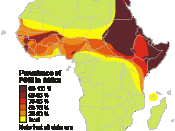Critique of Female Circumcision
In this infinitely diverse world filled with a myriad of equally distinct cultures, it is often difficult to understand things that are unfamiliar to us. Furthermore, our point of view is skewed by the context of our own surroundings making it difficult of view other cultures objectively. Those who practice female circumcision view it as sacred, while others outside are quick to pass judgment on excision and call it brutal. However, is the debate over female circumcision a case merely based on cultural relativism or can it be argued that excision is a violation of basic human rights that cannot be infringed upon.
Female circumcision, sometimes referred to as female genital mutilation or FGM, is a procedure preformed on girls usually before the age of ten. The ceremony is an elaborate ritual signifying the girl's entrance into womanhood, and is a much-celebrated event within the village.
The designated elderly woman of the village performs the circumcision, which involves removing the clitoris and possibly both the labia majora and labia minora. The surgery is often preformed with old razorblades, knifes, broken glass or a sharpened stone. Do to the highly unsanitary conditions under which most excisions are preformed, there is a high rate of infection among those who undergo the operation with some cases resulting in death. Much has been done to urge the groups practicing excision to allow the procedure to be done in more sterile clinics, while other efforts have been made to educate peoples on the dangers of the operation. Many places have outlawed the tradition, but it is still being practiced in as many as 26 African nations (Rachels 31).
Many women, in hopes of escaping circumcision, have fled to other countries. One woman, Fauzia Kassindja, was the youngest daughter in a devout...



Female circumcision
this essay does a good job relating both sides of the arguement. it explains the horrorsd of the procedure but also the reasoning behind. though i must say that i am not a fan of the idea, this essay helps me too see why.
6 out of 6 people found this comment useful.